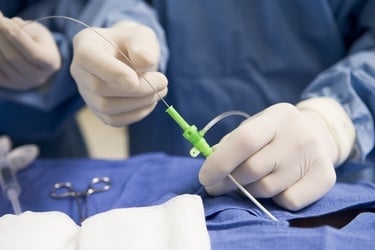If your physician needs to get some insight into how your heart is working, he or she may want to perform a heart cath. There are a number of uses for the procedure, from diagnostic to preventative, and it can give your healthcare team a robust picture of what your overall heart health looks like. In the past, cardiac catheterization was primarily performed through a blood vessel in the groin known as the femoral artery. Afterward, patients are unable to sit up or move about, being asked to keep their leg straight and immobile for 4 to 6 hours. However, now there is a new procedure through the wrist that offers all of the same benefits along with a lower risk of bleeding and higher level of convenience.
About Transradial Catheterization
Rather than accessing a blood vessel in the groin area, transradial cardiac catheterization uses an access point in the wrist known as the radial artery. This point of entry marks the only difference between the two procedures, but it makes a significant difference in terms of recovery, comfort, and safety for the patient. There is no down time, and those who receive transradial heart caths through the wrist can sit up, walk, and eat immediately following their procedure. Recovery times are quicker; hospital stays are shorter, and even patients receiving stents may be able to go home the same day. Most importantly, transradial catheterization is safer. Proximity to the abdominal cavity means that catheterization through the femoral artery poses a risk of bleeding into this space should the artery be punctured, a serious complication that may even lead to death. This risk is completely eliminated with the radial artery access point.
Uses for Transradial Catheterization
Physicians may use heart cath procedures to identify functional problems or disease and to open blocked arteries. A few common examples include:
- Check the pressure within the four chambers of your heart
- Inject a contrast dye used for x-ray imaging to find narrow or blocked arteries, also known as coronary angiography or coronary arteriography
- Perform a coronary angioplasty or other PCIs (percutaneous coronary interventions) with stenting to open blocked or narrowing arteries
- Look for defects in the heart’s valves or chambers
- Take blood to measure oxygen levels within the chambers
- Biopsy, or take a tissue sample for examination
Who is a Candidate for Transradial Catheterization?
Fortunately, most patients can undergo a transradial heart cath through the wrist without concern. However, there is a very small segment for whom the procedure may not be an option. Due to prior surgeries or injuries, some patients may have inadequate blood supply to the hand, making femoral artery catheterization a more viable option. For this reason, every patient is thoroughly evaluated to first determine their eligibility.
Within the U.S., 90 to 95 percent of all heart catheterizations are performed through the femoral artery in the groin. While most facilities don’t have the capabilities necessary for this procedure, Lane Regional Medical Center is the exception. In conjunction with Cardiovascular Institute of the South, our heart cath lab performs 90 percent of all heart cath procedures through the wrist, offering our patients a higher level of safety and convenience than can be found anywhere else in the region. To learn more about our cardiovascular center and physicians, click here.





